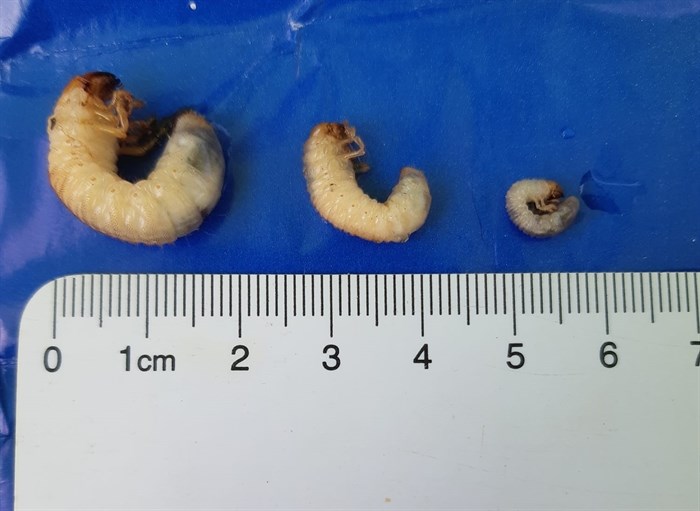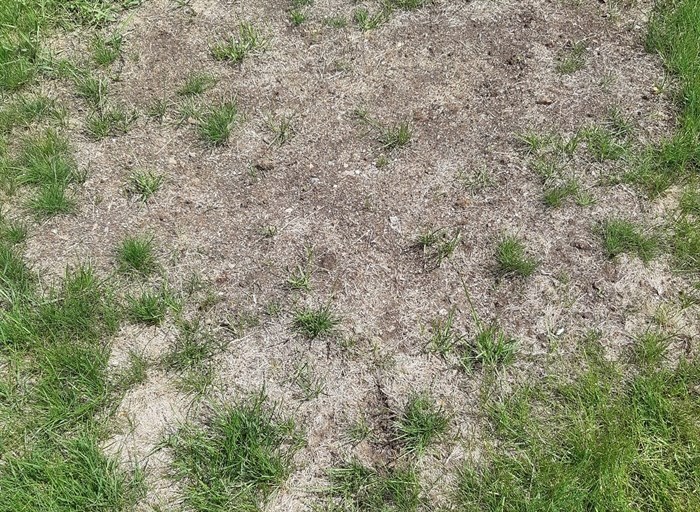
The larva of the European chafer beetle was found in a garden in Raleigh, a community near Kamloops.
Image Credit: SUBMITTED/ Anne Gregory
June 06, 2024 - 6:00 AM
An invasive beetle has been wreaking havoc on properties, parks and golf courses in the Thompson-Okanagan region this spring, causing large, dead patches of grass.
The European chafer beetle is a problem all over North America and was first introduced to BC in 2001, most likely brought in through infested turf from Europe, according to the Invasive Species Council of BC.
The larva or grubs of the beetle sit a few centimetres under the soil and chew through roots of grasses, ornamental plants and vegetables.
“I find some (larva) every year, mostly in my raised beds which had been let go prior to us purchasing the house,” Kamloops area gardener Anne Gregory said. Her lawn was damaged by the pest in early spring.
“I imagine I’m slowly whittling down their population. I do know they’re still there due to the damage to some of my root crops each year.”
Gregory disposes of the grubs by drowning them and smacks the beetles with a trowel. She recently reseeded the patches in her lawn.

This lawn in the Kamloops area was damaged by the larva of the invasive European chafer beetle.
Image Credit: SUBMITTED/ Anne Gregory
The owner at Outside the Box Horticulture Service in Kamloops, Katherine Ferguson, confirmed she is seeing a high number of grubs and damaged lawns this spring, particularly in the Westsyde and North Shore parts of the city.
The pest is increasing its range in the province and in 2023 was found in Revelstoke for the first time, according to the provincial government. The beetle is designated as a Management species by the BC Provincial Priority Invasive Species List.
The European chafer beetle has a one-year life cycle where the eggs hatch in the summer. The grubs feed in the fall, spend the winter 5 cm under the soil surface, and feed more in the spring.
In April, the grubs become pupae and the adult beetles emerge in June to mate and lay thousands of eggs in nearby turf areas.
READ MORE: Kamloops hiker finds creepy looking beetle with powerful defence mechanism
More damage to lawns occur in the fall when animals including skunks, raccoons and birds tear up the turf to get the grubs.
The adult beetles are medium-sized and tan coloured, while the grubs are white, and C-shaped with brown heads and grow up to 2.5 cm long. Beetles can be spotted flying around trees in June and can appear like buzzing bees when they fly.
According to the Invasive Council of BC, biocontrol methods can be used to treat the beetles, with many garden centres selling the nematode heterorhabditis bacteriophora, which feed on chafer beetle larvae.
READ MORE: iN PHOTOS: Mammoth-sized moths grab attention in Kamloops, Okanagan
Keeping a well-irrigated, healthy lawn can help, and taller turf is less preferable for the beetles to lay eggs on. Patches should be reseeded after the grubs have finished feeding and are in the pupae stage.
There are several types of pesticides available on the market for those property owners dealing with large or aggressive infestations.
“We recommend applying pesticides three times per year, May, June and July,” Ferguson said. “July is the most important month to spray.”
To contact a reporter for this story, email Shannon Ainslie or call 250-819-6089 or email the editor. You can also submit photos, videos or news tips to the newsroom and be entered to win a monthly prize draw.
We welcome your comments and opinions on our stories but play nice. We won't censor or delete comments unless they contain off-topic statements or links, unnecessary vulgarity, false facts, spam or obviously fake profiles. If you have any concerns about what you see in comments, email the editor in the link above. SUBSCRIBE to our awesome newsletter here.
News from © iNFOnews, 2024